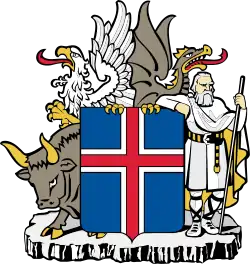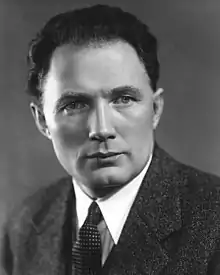1956 Icelandic parliamentary election
Parliamentary elections were held in Iceland on 24 June 1956.[1] The Independence Party remained the largest party in the Lower House of the Althing, winning 13 of the 35 seats.[2]
| ||||||||||||||||||||||||||||||||||||||||||||||||||||||||||||||||
All 35 seats in the Lower House and 17 seats in the Upper House of Althing | ||||||||||||||||||||||||||||||||||||||||||||||||||||||||||||||||
| Turnout | 92.07% | |||||||||||||||||||||||||||||||||||||||||||||||||||||||||||||||
|---|---|---|---|---|---|---|---|---|---|---|---|---|---|---|---|---|---|---|---|---|---|---|---|---|---|---|---|---|---|---|---|---|---|---|---|---|---|---|---|---|---|---|---|---|---|---|---|---|---|---|---|---|---|---|---|---|---|---|---|---|---|---|---|---|
| ||||||||||||||||||||||||||||||||||||||||||||||||||||||||||||||||
 |
|---|
|
|
Electoral system
The elections were conducted under two electoral systems. Twenty-one members were elected in single-member constituencies via first-past-the-post voting, while the remainder were elected using D'Hondt method proportional representation: twelve members in two-member constituencies, eight members in Reykjavík, and eleven from a single national compensatory list. To earn national list seats, a party had to win at least one constituency seat. In constituencies electing two or more members, within the party list, voters had the option to re-rank the candidates and could also strike a candidate out. Allocation of seats to candidates was done using a system based on the Borda count.[3]
Results
| Party | Votes | % | Seats | |||||
|---|---|---|---|---|---|---|---|---|
| Lower House | +/– | Upper House | +/– | |||||
| Independence Party | 35,027 | 42.37 | 13 | –1 | 6 | –1 | ||
| People's Alliance | 15,859 | 19.18 | 5 | 0 | 3 | +1 | ||
| Social Democratic Party | 15,153 | 18.33 | 6 | +2 | 2 | 0 | ||
| Progressive Party | 12,925 | 15.63 | 11 | +1 | 6 | 0 | ||
| National Preservation Party | 3,706 | 4.48 | 0 | –2 | 0 | 0 | ||
| Independents | 8 | 0.01 | 0 | New | 0 | New | ||
| Total | 82,678 | 100.00 | 35 | 0 | 17 | 0 | ||
| Valid votes | 82,678 | 98.01 | ||||||
| Invalid/blank votes | 1,677 | 1.99 | ||||||
| Total votes | 84,355 | 100.00 | ||||||
| Registered voters/turnout | 91,618 | 92.07 | ||||||
| Source: Nohlen & Stöver | ||||||||
References
- Dieter Nohlen & Philip Stöver (2010) Elections in Europe: A data handbook, p961 ISBN 978-3-8329-5609-7
- Nohlen & Stöver, p976
- Renwick, Alan (2010). Helgason, Þorkell; Hermundardóttir, Friðný Ósk; Simonarson, Baldur (eds.). "Electoral System Change in Europe since 1945: Iceland" (PDF). Electoral system change since 1945. Archived (PDF) from the original on 4 October 2021. Retrieved 4 October 2021.
